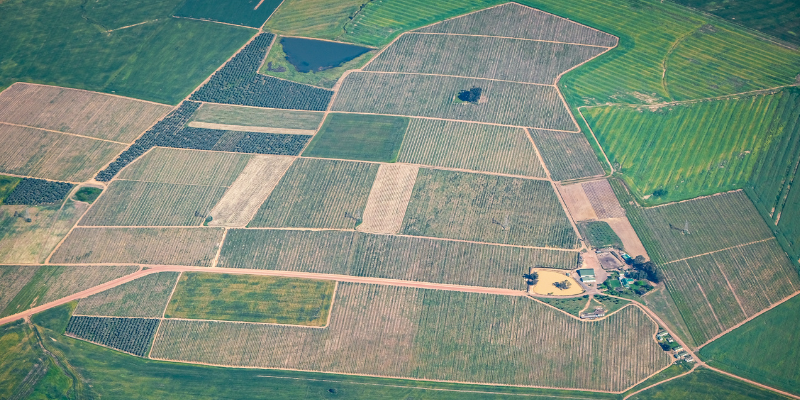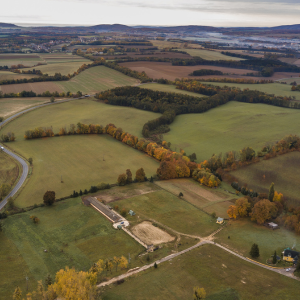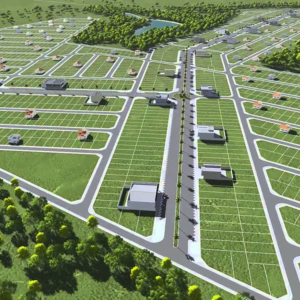
Understanding the Fundamentals of Acreage Measurements
Correct acreage calculations are crucial for investments, especially when dealing with a hundred acres. An acre is 43,560 square feet or part of a land measurement system in the imperial and U.S. customary systems. Access to this benchmark is necessary because the investor considers buying and selling multiple properties, which has advantages.
Acquiring a hundred acres of land leads one to envision endless sprawling opportunities, such as constructing residential buildings and commercial centers or harnessing agriculture. Correctly estimating such a vast region puts the scope into perspective; for instance, it is worth around seventy-five football fields, along with half a mile squared.
Understanding these fundamentals helps stakeholders accurately gauge the opportunities and challenges associated with such a large parcel of land in real estate and housing markets. We Buy Land Quick can help clarify how familiarity with acreage measurements allows for informed decision-making regarding zoning regulations, development potential, and investment prospects.
The History and Evolution of Acreage as a Measurement Unit
Originally grounded in the Neolithic era, when land was segmented based on farming potential, acreage gradually evolved to measure the expanse. An acre of land was plowed in a day with a yoke of oxen. This definition varied greatly based on local conditions and existing farming practices.
In medieval England, Acre) was further standardized as a strip of land measuring 1 furlong long by 4 rods wide (43,560 square feet). This came around as English society marked expansion periods alongside a rise in trading systems.
This standardization facilitated more precise land division and sale, laying a foundation for modern real estate practices. As urbanization accelerated during the Industrial Revolution and beyond, acres became crucial for city planning and development projects.
Acreage comprehension in real estate and housing markets today is crucial as it indicates size, providing value to investors, land buyers in San Antonio and all over Texas, sellers, developers, and even planners. The history from a rough, informal agrarian measurement to a scientifically calculable figure shows how a society progresses and gains the need for precision and uniformity in land resource management.
Comprehensive Guide to Land Size and Acreage
In real estate and housing, size and scope are often important, particularly with greater extents such as 100 acres. Since an acre equals 43,560 square feet, 100 acres equals 4,356,000 square feet.
With this much space, there is potential for many multi-use developments, including residential housing and large-scale commercial projects. To put in perspective what 100 acres look like, it can easily fit many houses, along with ample areas designated for community centers, parks, and recreational spaces.
In rural areas, this land might be used for agricultural purposes or left as a natural habitat. When considering zoning laws and building regulations in real estate planning, the sheer size of 100 acres opens up a wide range of opportunities. It also requires careful management to maximize its potential while adhering to legal constraints.
Understanding acreage helps investors and developers envision how land can be effectively utilized to meet market demands while sustaining long-term growth in the real estate sector. Contact us for guidance tailored to your project.
Comparing Acreage Sizes: From Small Plots to Expansive Lands

To help visualize over 100 acres of real estate and housing, it makes sense to compare it to an acre, which stands 43,560ft²and is equivalent to an American football field.
An estate can form a quarter or a half acre of land, ideal for residential suburbs. On the other hand, a hundred acres offer limitless possibilities and unmatched topography.
This vast space can support several housing development projects, large-scale agricultural operations, or a mixed-use development comprising commercial and residential portions. The availability of such a large area aids in strategically planning for critical elements like community green spaces, recreation facilities, conservation areas, and some developed regions.
Understanding these size differences is crucial for real estate investors and developers when considering potential projects and their impact on surrounding environments.
Exploring the Dimensions and Scale of 100 Acres
Examining 100 acres can also be a good investment for real estate development and property. It offers significantly more than 4,356,000 square feet, which could be constructed.
If people wanted to construct homes in such a large area, 100 Acres would accommodate single-attached units, clustered homes, multi-story apartment blocks, and well-designed parks. It permits systematic urban growth while accommodating the future development of cities with beautiful gardens and green spaces.
In commercial real estate, 100 acres can accommodate large-scale projects such as shopping centers or mixed-use developments that combine retail and residential living spaces. The remarkable expanse of 100 acres is also advantageous regarding zoning restrictions, making it easier for developers to build sustainable communities that evolve harmoniously.
Understanding this scale is crucial for investors and planners who seek to optimize land use while maximizing return on investment in the competitive real estate market.
How to Visualize 100 Acres in Real-world Terms

Understanding 100 acres of real estate may be complex, but I can simplify it. Visualize a standard American football field with both end zones; one acre is equivalent to its size.
Now, imagine 100 of these fields placed next to each other. The area they span would be much greater than most people encounter daily. Concerning the previous subtopics, an ideal metropolitan neighborhood of a city is 100 acres in size.
Shifting the frame of consideration to residential purposes could host hundreds of houses, though it depends on lot size regulations and zoning laws. On the other hand, this space could also comfortably accommodate a massive shopping mall and its associated parking area, which consumes approximately 100 acres combined.
For people familiar with rural areas, imagine the vast farmland or thick forests surrounding this region. This area presents limitless opportunities for growth or preservation. Comparing these real-world ideas to 100 acres simplifies understanding their impact on real estate and housing development.
Practical Applications of 100-acre Land Parcels
In real estate and housing, a 100-acre land parcel offers vast opportunities for diverse practical applications, making it a highly valuable asset. Such an expansive area provides ample space for developing residential communities, potentially accommodating multiple housing units while maintaining spaciousness and privacy.
This acreage is ideal for creating mixed-use developments that seamlessly blend residential, commercial, and recreational spaces. Developers can also explore agricultural ventures, taking advantage of the land’s size to cultivate crops or establish sustainable farming practices.
Additionally, 100 acres offer the possibility of constructing luxury estates with extensive grounds, allowing for features like private gardens, equestrian facilities, or even golf courses. The sheer size of these parcels makes them attractive for conservation projects as well; they can support habitats for wildlife or serve as natural preserves.
Moreover, large plots like these provide flexibility in zoning and planning, enabling developers to design innovative layouts that cater to the evolving demands of modern living while optimizing land use efficiency.
How Big Is 100 Acres in Football Fields?

Interpreting the sheer size of 100 acres as real estate or land requires an analogy one is more familiar with, in this case, football fields. This understanding aids development and business activities within a given area.
An average football field takes up approximately 32 acres of land when accounting for both end zones. Therefore, 100 acres would be equivalent to about 75 full-sized football fields. Such a scope allows one to embark on many projects, such as residential subdivisions, commercial and recreational parks, and agricultural activities.
This comparison illustrates the considerable land available within a 100-acre block and reinforces its value for multi-dimensional housing construction and community development in real estate. Understanding how large 100 acres are relative to football fields offers a practical perspective that is valuable for developers and potential cash land buyers in Houston and other Texas cities when trying to appreciate the scale of such property.
How Much Do 100 Acres of Land Look Like?
When considering the vastness of 100 acres in real estate and housing, it’s essential to visualize how expansive this land area is. One hundred acres of land equals approximately 4,356,000 square feet, or about 16 square miles. To put this into perspective, imagine a parcel of land that can accommodate around 75 football fields side by side.
This expansive area provides ample opportunities for diverse real estate developments across both buildable and non-buildable land, from sprawling residential communities with multiple homes and amenities to large-scale agricultural projects or mixed-use developments combining commercial and residential spaces. In terms of housing, 100 acres can host a substantial number of homes while still preserving open space for parks, trails, or community centers.
Understanding such a large plot’s dimensions and potential uses can help investors and developers appreciate its value and versatility in the real estate market.
How Big in Miles Is 100 Acres?
Converting this measurement into more familiar terms is essential when considering the vastness of 100 acres in real estate and housing. One acre is equivalent to 43,560 square feet. Therefore, 100 acres translates to a staggering 4,356,000 square feet. To better visualize this expanse in terms of miles, it’s crucial to understand that one mile equals 5,280 feet.
By converting acres into miles, we find that 100 acres is approximately 15625 square miles. This sizable area can accommodate various real estate developments and housing projects, offering ample space for residential communities or expansive estates. Understanding the dimensions of 100 acres in miles helps potential investors and developers grasp the sheer scale of land they are dealing with in real estate ventures.
What Is the Measurement of 100 Acres?
A hundred acres is a significant measurement in real estate and housing, equivalent to 4,356,000 square feet or approximately 40.47 hectares. When trying to visualize the vastness of 100 acres, it helps to consider that one acre is about 43,560 square feet, roughly the size of a standard American football field without the end zones.
Therefore, 100 acres would encompass about 75 football fields placed side by side. In terms of dimensions, if you were to create a perfect square out of 100 acres, each side would measure approximately 2,087 feet.
Understanding the scale of such a large parcel of land is crucial for real estate developers and potential homeowners considering large-scale projects or rural living spaces. This expanse can accommodate numerous residential units or expansive agricultural endeavors while offering ample space for recreational facilities or community parks.
The vastness of 100 acres provides endless possibilities for development and landscaping in the housing market.
Do you need to sell your land? Sell quickly and have a hassle-free sale. We Buy Land Quick is here to help. We offer fair cash offers, handle all the details, and make the process seamless. Ready to sell or have questions? Call us at (469) 529-7977 for a no-obligation offer. Get started today!
| LENGTH | LINEAL FEET |
Helpful Texas Blog Articles
- How to Market Land for Sale: Top Tips
- A No-Lawyer Guide to Selling Land
- Guide To Selling A Part Of Your Land in Texas
- Selling Land To Developers In Texas
- Understanding The Vastness Of 100 Acres
- Selling Non-buildable Land In The Real Estate Market
- Can You Build on Your Land? Zoning Rules Explained
- Can You Rent Out Land Instead of Selling It?
- Comprehensive Guide To Evaluating Your Land’s Worth In Texas
- Understanding Closing Costs For Land Purchases In Texas
- How to Find Out the Zoning of My Land in Texas
- How to Sell Hunting Land in Texas
- Real Estate Commissions and Commission on Land Sales in Texas

